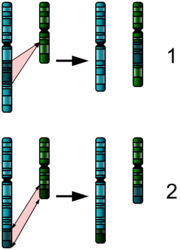A chromosome abnormality reflects an abnormality of chromosome number or structure. Chromosome abnormalities usually occur when there is an error in cell division following meiosis or mitosis. There are many types of chromosome abnormalities. They can be organized into two basic groups, numerical and structural abnormalities.
Numerical abnormalities
When an individual is missing either a chromosome from a pair (monosomy) or has more than two chromosomes of a pair (trisomy). An example of a condition caused by numerical abnormalities is Down Syndrome, also known as Trisomy 21 (an individual with Down Syndrome has three copies of chromosome 21, rather than two). Turner Syndrome is an example of a monosomy where the individual is born with only one sex chromosome, an X.
Structural abnormalities
When the chromosome's structure is altered. This can take several forms:
- Deletions: A portion of the chromosome is missing or deleted. Known disorders include Wolf-Hirschhorn syndrome, which is caused by partial deletion of the short arm of chromosome 4; and Jacobsen syndrome, also called the terminal 11q deletion disorder.
- Duplications: A portion of the chromosome is duplicated, resulting in extra genetic material. Known disorders include Charcot-Marie-Tooth disease type 1A which may be caused by duplication of the gene encoding peripheral myelin protein 22 (PMP22) on chromosome 17.
- Translocations: When a portion of one chromosome is transferred to another chromosome. There are two main types of translocations. In a reciprocal translocation, segments from two different chromosomes have been exchanged. In a Robertsonian translocation, an entire chromosome has attached to another at the centromere; these only occur with chromosomes 13, 14, 15, 21 and 22.
- Inversions: A portion of the chromosome has broken off, turned upside down and reattached, therefore the genetic material is inverted.
- Rings: A portion of a chromosome has broken off and formed a circle or ring. This can happen with or without loss of genetic material.
- Isochromosome: Formed by the mirror image copy of a chromosome segment including the centromere.
Chromosome instability syndromes are a group of disorders characterized by chromosomal instability and breakage. They often lead to an increased tendency to develop certain types of malignancies.
Inheritance
Most chromosome abnormalities occur as an accident in the egg or sperm, and are therefore not inherited. Therefore, the abnormality is present in every cell of the body. Some abnormalities, however, can happen after conception, resulting in mosaicism (where some cells have the abnormality and some do not). Chromosome abnormalities can be inherited from a parent or be "de novo". This is why chromosome studies are often performed on parents when a child is found to have an abnormality.
http://en.wikipedia.org/wiki/Chromosome_abnormalities


No comments:
Post a Comment